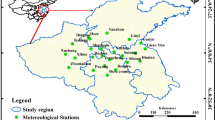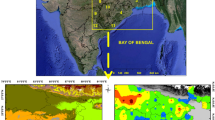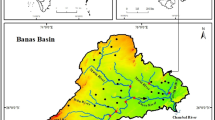Abstract
Urbanisation has burdened cities with many problems associated with growth and the physical environment. Some of the urban locations in India are becoming increasingly vulnerable to natural hazards related to precipitation and flooding. Thus it becomes increasingly important to study the characteristics of these events and their physical explanation. This work studies rainfall trends in Delhi and Mumbai, the two biggest Metropolitan cities of Republic of India, during the period from 1951 to 2004. Precipitation data was studied on basis of months, seasons and years, and the total period divided in the two different time periods of 1951–1980 and 1981–2004 for detailed analysis. Long-term trends in rainfall were determined by Man-Kendall rank statistics and linear regression. Further this study seeks for an explanation for precipitation trends during monsoon period by different global climate phenomena. Principal component analysis and Singular value decomposition were used to find relation between southwest monsoon precipitation and global climatic phenomena using climatic indices. Most of the rainfall at both the stations was found out to be taking place in Southwest monsoon season. The analysis revealed great degree of variability in precipitation at both stations. There is insignificant decrease in long term southwest monsoon rainfall over Delhi and slight significant decreasing trends for long term southwest monsoon rainfall in Mumbai. Decrease in average maximum rainfall in a day was also indicated by statistical analysis for both stations. Southwest monsoon precipitation in Delhi was found directly related to Scandinavian Pattern and East Atlantic/West Russia and inversely related to Pacific Decadal Oscillation, whereas precipitation in Mumbai was found inversely related to Indian ocean dipole, El Niño- Southern Oscillation and East Atlantic Pattern.








Similar content being viewed by others
References
Bainnes PG, Folland CK (2007) Evidence for a rapid climate shift across the late 1960s. J Clim 20:2721–2744
Bretherton CS, Smith C, Wallace JM (1992) An intercomparison of methods for finding coupled patterns in climate data. J Climate 5:541–560
Chhabra BM, Prakasa Rao GS, Joshi UR (1997) A comparative study of differences in the averages of temperatures and rainfall over the Indian stations during the periods 1931–1960 and 1961–1990. Mausam 48(1):65–70
De US, Dandekar MM (2001) Natural disasters in urban areas. Deccan Geographer 39:1–12
del Rio S, Penas A, Fraile R (2005) Analysis of recent climatic variations in Castile and Leon (Spain). Atmos Res 73:69–85
Dymnikov VP, Filin SK (1985) A study of the correlations between sea-surface temperature anomilies in mid-latitudes and anomilies in heating, based on data from the first GARP Global Experiment. Reprint of the Department of Numerical Mathematics of the U.S.S.R Academy of Sciences
Fukoka A (1951) A study on 10 day forecast (a synthetic report). Geophys Mag 22:117–208
Gadgil A, Dhorde A (2005) Temperature trends in twentieth century at Pune, India. Atmos Environ 39:6550–6556
Goswami BN et al (2006) Increasing trend of extreme rain events over India in a warming environment. Science 314(5804):1442–1445. doi:10.1126/science.1132027
Guhathakurta P, Rajeevan M (2006) Trends in the rainfall pattern over India. NCC Research Report No 2/2006. National Climate Centre. India Meteorological Department, pp 23
Holmstrom I (1963) On a method of parametric representation of the atmosphere. Tellus 15:127–149
Jagannathan P, Bhalme HN (1973) Changes in pattern of distribution of southwest monsoon rainfall over India associated with sunspots. Mon Weather Rev 101:691–700
Joseph PV, Xavier PK (1999) Monsoon rainfall and frequencies of monsoon depressions and tropical cyclones of recent 100 years and an outlook for the first decades of 21st Century. Meteorology beyond 2000. In: Proceedings of Indian Meteorological Society. TROPMET-99. pp 364–371
Joshi UR, Rajeevan M (2006) Trends in precipitation extremes over India. Research report No 3/2006. National Climate Centre. Indian Meteorological Department
Katzbach J (1967) Empirical eigenvectors of sea-level pressure, surface temperature and precipitation complexes over North America. J Appl Meteor 6:791–802
Koteswaram P, Alvi SMA (1969) Secular trends and periodicities in rainfall at west coast stations in India. Curr Sci 101:371–375
Kumar JR, Dash SK (2001) Interdecadal variations of characteristics of monsoon disturbances and their epochal relationships with rainfall and other tropical features. Int J Climatol 21:759–771
Kumar K, Pant GB, Parthasarathy B, Sontakke N (1992) Spatial and sub-seasonal patterns of the long-term trends of Indian summer monsoon rainfall. Int J Climatol 12:257–268
Lanzante JR (1984) A rotated eigen-analysis of the correlation between 700-mb heights and sea surface temperatures in the Pacific and Atlantic. Mon Wea Rev 112:2270–2280
Lorenz EN (1956) Empirical orthogonal functions and statistical weather prediction. Sci. Rep. No. 1. Statistical Forecasting Project. Department of Meteorology. Massachusetts Institute of Technology
McCarthy JJ, Canziani OF, Leary NA, Dokken DJ, White KS, (eds) (2001) In: Climate change- impacts, adaptations and vulnerability. Inter-governmental panel on climate change (IPCC) report
Mitchell JM Jr, Dzerdzeevskii B, Flohn H, Hofmeyr WL, Lamb HH, Rao KN, Wallen CC (1966) Climate change. World Meteorological Organisation. Technical note no 79. WMO 195. TP 100. Secretariat of WMO. Geneva, Switzerland
Mooley DA, Parthasarathy B (1984) Variability of Indian summer monsoon rainfall and tropical circulation features. Mon Weather Rev 111:967–968
Naidu CV, Rao BRS, Rao DVB (1999) Climatic trends and periodicities of annual rainfall over India. Meteorol Appl 6:395–404
Obukhov AM (1960) On statistical orthogonal expansions in empirical functions. Izvest Geophys Ser (Eng. Trans) 5:288–291
Pant GB, Borgaonkar HP (1984) Climate of the Hill regions of Uttar Pradesh. Himal Res Dev 3:13–20
Pant GB, Rupa Kumar K, Borgaonkar HP (1999) Climate and its long-term variability over the Western Himalaya during the past two Centuries. In: Dash SK, Bahadur J (eds) The Himalayan environment. New Age International (P) Limited Publishers, New Delhi, pp 171–184
Parthasarathy B (1984) Inter annual and long term variability of Indian summer monsoon rainfall. Proc Indian Acad Sci (Earth Planet Sci) 93:371–385
Parthasarathy B, Kumar KR, Munot AA (1993) Homogeneous Indian monsoon rainfall—variability and prediction. Proc Indian Acad Sci Earth Planet Sci 102:121–155
Pearson K (1902) On lines and planes of closest fit to system of points in space. Philos Mag 6:559–572
Pramanik SK, Jagannathan P (1954) Climate change in India—1: rainfall. Indian J Meteorol Geophys 4:291–309
Prohaska J (1976) A technique for analyzing the linear relationships between two meteorological fields. Mon Wea Rev 104:1345–1353
Rao KN, Jagannathan P (1963) Climate change in India—1. In: Proceedings of symposium on changes in climate. UNESCO and WHO, Rome, pp 49–66
Roy SS (2006) The impacts of ENSO, PDO, and local SSTs on winter precipitation in India. Phys Geogr 27:464–474
Singh OP (2001) Multivariate ENSO index and Indian monsoon rainfall: relationships on monthly and subdivisional scales. Meteorol Atmos Phys 78:1–9
Singh N, Sontakke NA (1999) On the variability and prediction of rainfall in the post-monsoon season over India. Int J Climatol 19:309–339
Srivatsava HN, Dewan BN, Dikshit SK, Prakasa Rao GS, Singh SS, Rao KR (1992) Decadal trends in climate over India. Mausam 43:7–20
Thapliyal V, Kulshrestha SM (1991) Climate changes and trends over India. Mausam 42:333–338
Tomozeiu R, Pavan V, Cacciamani C, Amici M (2006) Observed temperature changes in Emilia-Romagna: mean values and extremes. Clim Res 31:217–225
Author information
Authors and Affiliations
Corresponding author
Rights and permissions
About this article
Cite this article
Rana, A., Uvo, C.B., Bengtsson, L. et al. Trend analysis for rainfall in Delhi and Mumbai, India. Clim Dyn 38, 45–56 (2012). https://doi.org/10.1007/s00382-011-1083-4
Received:
Accepted:
Published:
Issue Date:
DOI: https://doi.org/10.1007/s00382-011-1083-4




